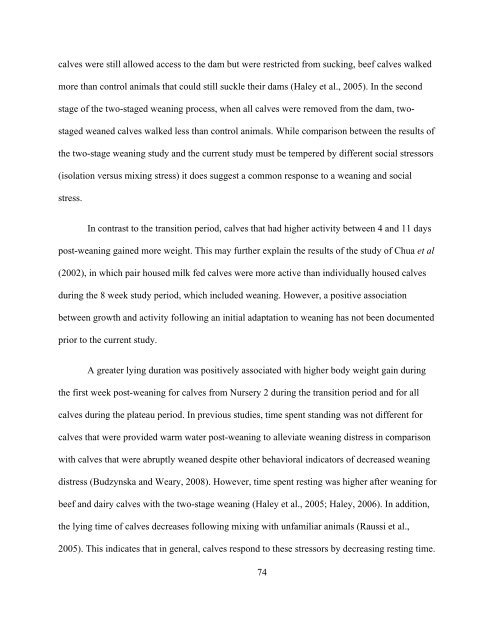Stanton PhD Thesis final_docx - Atrium - University of Guelph
Stanton PhD Thesis final_docx - Atrium - University of Guelph
Stanton PhD Thesis final_docx - Atrium - University of Guelph
Create successful ePaper yourself
Turn your PDF publications into a flip-book with our unique Google optimized e-Paper software.
calves were still allowed access to the dam but were restricted from sucking, beef calves walked<br />
more than control animals that could still suckle their dams (Haley et al., 2005). In the second<br />
stage <strong>of</strong> the two-staged weaning process, when all calves were removed from the dam, two-<br />
staged weaned calves walked less than control animals. While comparison between the results <strong>of</strong><br />
the two-stage weaning study and the current study must be tempered by different social stressors<br />
(isolation versus mixing stress) it does suggest a common response to a weaning and social<br />
stress.<br />
In contrast to the transition period, calves that had higher activity between 4 and 11 days<br />
post-weaning gained more weight. This may further explain the results <strong>of</strong> the study <strong>of</strong> Chua et al<br />
(2002), in which pair housed milk fed calves were more active than individually housed calves<br />
during the 8 week study period, which included weaning. However, a positive association<br />
between growth and activity following an initial adaptation to weaning has not been documented<br />
prior to the current study.<br />
A greater lying duration was positively associated with higher body weight gain during<br />
the first week post-weaning for calves from Nursery 2 during the transition period and for all<br />
calves during the plateau period. In previous studies, time spent standing was not different for<br />
calves that were provided warm water post-weaning to alleviate weaning distress in comparison<br />
with calves that were abruptly weaned despite other behavioral indicators <strong>of</strong> decreased weaning<br />
distress (Budzynska and Weary, 2008). However, time spent resting was higher after weaning for<br />
beef and dairy calves with the two-stage weaning (Haley et al., 2005; Haley, 2006). In addition,<br />
the lying time <strong>of</strong> calves decreases following mixing with unfamiliar animals (Raussi et al.,<br />
2005). This indicates that in general, calves respond to these stressors by decreasing resting time.<br />
74

















